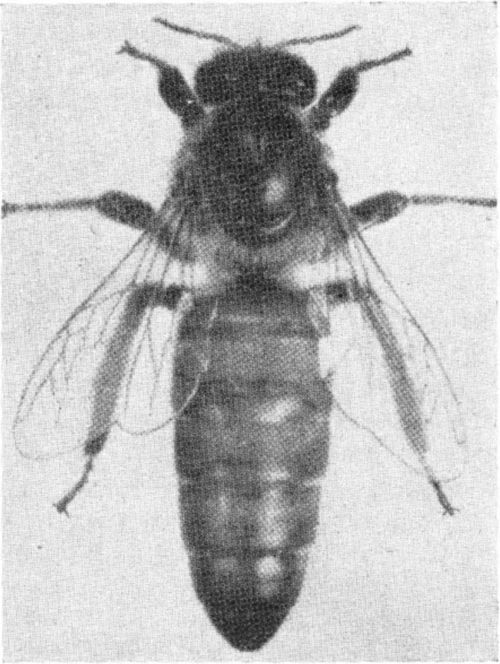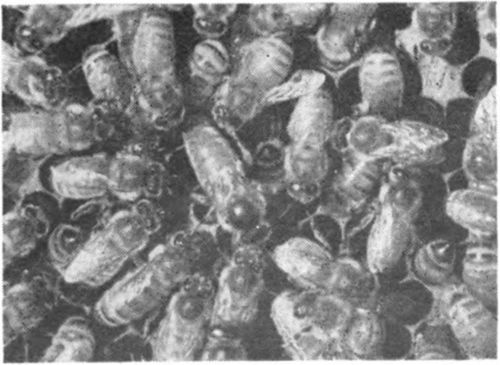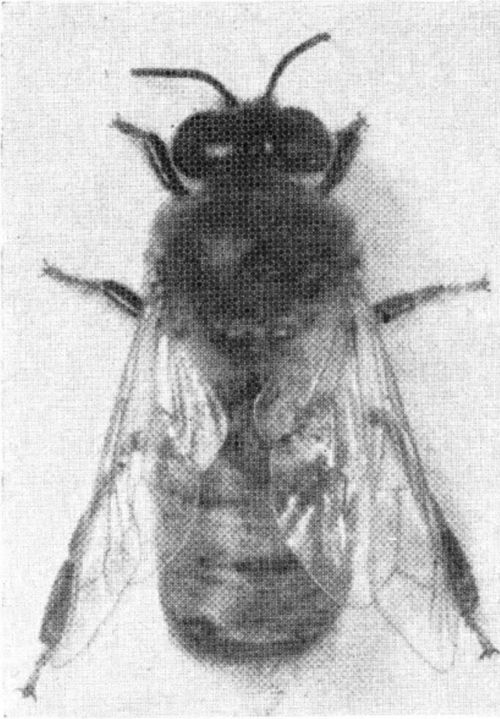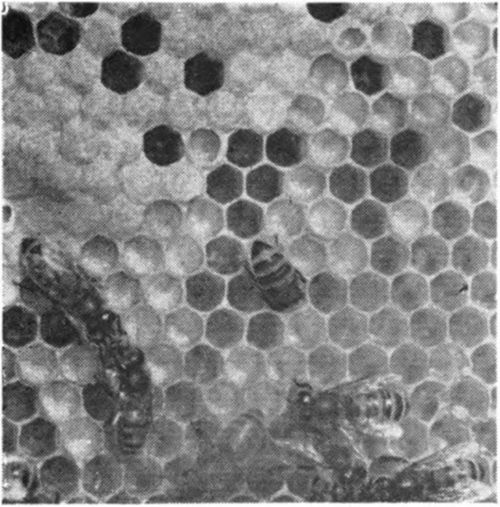The Honey Bee Colony. Continued
Description
This section is from the book "Beekeeping for Beginners", by G. H. Cale, Jr.. Also available from Amazon: Beekeeping for Beginners.
The Honey Bee Colony. Continued
The Queen Bee
The queen bee is truly the mother of the colony. The entire colony life is dependent upon her efforts, for without the eggs she lays the colony would soon die. She is the only perfect female in the hive, differing from the workers in that she has perfectly developed sexual organs and has the ability to lay eggs.

The queen bee
She passes through the same stages of development that the worker bee does. The difference between the queen and the worker is determined during the larval stage. A larva which is fed an extremely rich mixture of food, called royal jelly, develops into the queen bee, while the workers are fed a less concentrated food and remain as sexually undeveloped females. The time consumed in development from the egg to the adult is 16 days for the queen.
The queen bee has but one function in the colony and that is to lay eggs. Day after day the queen continues her tireless efforts, laying thousands of eggs which will develop into more bees. A superior queen has been known to lay as many as 3000 eggs a day, but the usual average is from 1200 to 1800.
Though the queen rightly deserves her name through the fact that she is responsible for the success or failure of the colony she heads through her egg laying ability, she is by no means a ruling tyrant. Not only does she not go to the fields to gather pollen and honey, but she is even dependent on the bees of the hive for her daily food. They wait on her hand and foot, surrounding her in an amicable circle, feeding her from their own mouth parts and removing her excrements as fast as deposited.
But she is virtually a prisoner within the hive, never leaving it after her nuptial mating flight, unless she goes out with a swarm; and if she becomes old or incapacitated, she is replaced and disposed of without ado by the workers of the colony.
While she has a sting, it is never used in stinging other bees or animals or other objects, but is reserved for her possible battle royal with another hostile queen. Under such circumstances, the battle of the queens may be likened to the battle of hostile male deer or moose in the forest. May the better win, and evidently the bees do not interfere.

Note the comparative size of the queen and the workers. The queen is the large bee in the center. See how the worker bees surround and face the queen as they care for and protect her. Wherever she goes in the colony the workers make way for their queen.
The Drone Bee
The drone bee is the male. He is easily distinguished from the others by the prominence of the two large compound eyes, larger than those of the queen and the worker (one on either side of the head), and by his blunt abdomen. In size the drone falls between the queen and the workers-being larger than the worker and smaller than the queen.
The drone passes through the same stages of development as the queen and the worker-the only difference being that it takes the drone 24 days to develop from the egg to the adult bee.

The drone bee
The drone has only one function in the colony, that of mating with the queen bee. The queen mates only early in her lifetime (shortly after emergence as an adult) so it can be readily seen that after the queen is mated and laying the drone is a useless burden to the colony. The majority of the time the drone is in the way in the colony and as winter approaches the workers drive the drones from the colony so that they perish from cold and starvation.
This big bumbling male has neither a sting to protect himself and his colony, nor proper mouthparts for securing honey from the flowers. He does help himself freely to the bounty within the hive which has been collected by the worker bees. And he is welcomed by them as long as there is nectar in the field and there may be need for new queens to head new colonies on account of the crowded condition within the colony. He may even enter a strange colony unmolested.
But woe be to him when the summer wanes and the breath of winter is in the air. The drone seems to sense his fate, and opening the hive you may find the drones grouped in the very far upstairs corners of the hive evidently hoping that in that isolated spot they may be unnoticed and thus gain a few more days of respite before the day of reckoning comes.
And yet, in a queenless colony, these same drones may be allowed to remain throughout the winter. Something tells the bees of the colony that drones are necessary for the development of the egg-laying powers of a new queen, and they retain the drones in the hope that in some way these big harmless gluttons may solve their problem.
Even in the fulfilling of his mission in life-mating with the queen while in flight in the air-there is a bit of irony. For the successful drone never lives to see the birth of his progeny. His sexual organs are torn from him by the ravished queen, and he drops to the earth, his mission accomplished at the cost of his life.
The Colony
Put the workers, the queen and the drones together, give them a home and allow them sufficient time to build their combs and you have a colony. The number of bees in this colony may vary all the way from a few thousand to a hundred thousand or even more. Bees may be described as social insects, that is, they band together and have a division of work among themselves.
In its natural environment, the colony is found among the limbs of trees, in a hollow log or tree, in a cave or on the side of a cliff. Even in our advanced time of modern hives and modern method of handling, bees have changed little in a thousand years. The colony will swarm, and the swarm will seek for itself the most convenient place possible for starting the new colony, be it house attic, side walls or gable roof, bird box, or even the top of an automobile.

A natural colony among the limbs of a tree.

Bee comb, showing worker bees carrying on one of their functions of feeding young larvae. Notice the concise, geometrical design of the cells. The young larvae may be seen coiled in the bottom of the cells. The bee in the center of the picture is placing food in a cell containing a young larva. To the left of the picture a field bee can be seen delivering nectar to a house bee.
But be it in an improvised hive or in a modern hive, the colony is comprised of three kinds of bees and the comb in which is contained the honey, pollen, eggs, larvae, and pupae of the honey bee colony, the only marked difference being that in the one instance the combs are built straight and are easily removed for examination, while in the other they are built crisscross and make entry difficult.
Continue to:


